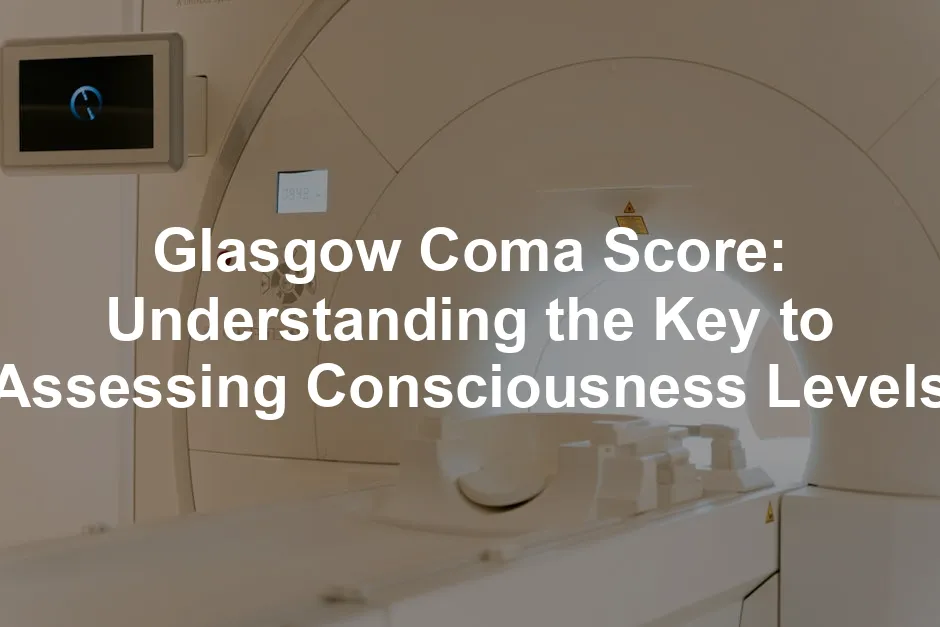Introduction
The Glasgow Coma Score (GCS) is crucial for medical evaluations. It helps assess consciousness levels, especially after brain injuries. This tool enables healthcare providers to make informed decisions about patient care.
For those looking to delve deeper into the subject, grabbing a copy of Glasgow Coma Scale: A Comprehensive Guide for Clinicians could be your next best decision.
Summary and Overview
The Glasgow Coma Scale was developed in 1974 by Graham Teasdale and Bryan Jennett. Its purpose is to measure the level of consciousness in patients. The GCS uses a scoring system based on eye, verbal, and motor responses. Each component contributes to an overall score, ranging from 3 to 15.
In clinical settings, GCS aids in diagnosing the severity of brain injuries. Higher scores indicate better neurological function, while lower scores suggest more severe impairments. GCS plays a vital role in guiding treatment decisions and monitoring patient progress. Research shows a clear relationship between GCS scores and patient outcomes. Lower scores often correlate with increased mortality rates, making it an essential tool in emergency medicine.

For those in emergency medical services, the book Emergency Medical Responder: First on Scene can provide critical insights.
Understanding the Glasgow Coma Scale
What is the Glasgow Coma Scale?
The GCS measures consciousness levels in patients. It assesses responsiveness through three main criteria: eye-opening, verbal response, and motor response. Teasdale and Jennett created this scale in 1974, aiming for a simple yet effective tool for evaluating brain function.
Components of the GCS
The Glasgow Coma Scale (GCS) measures consciousness through three main components: Eye Opening, Verbal Response, and Motor Response. Each part plays a crucial role in assessing a patient’s neurological state.
1. Eye Opening
- Spontaneous: Opens eyes without any stimuli (4 points).
- To verbal command: Responds to voice (3 points).
- To pain: Opens eyes in response to pain stimuli (2 points).
- None: No eye opening at all (1 point).
2. Verbal Response
- Oriented: Can converse coherently and is aware (5 points).
- Confused: Responds but is disoriented (4 points).
- Inappropriate words: Uses words but inappropriately (3 points).
- Incomprehensible sounds: Produces sounds but no words (2 points).
- None: No verbal response (1 point).
3. Motor Response
- Obeys commands: Follows simple instructions (6 points).
- Localizes pain: Moves towards a painful stimulus (5 points).
- Withdrawal: Pulls away from pain (4 points).
- Flexion: Abnormal flexion to pain (3 points).
- Extension: Abnormal extension to pain (2 points).
- None: No motor response (1 point).
Scoring System
Each component of the GCS is scored separately, allowing for a detailed assessment. The total GCS score is calculated by adding the scores from the three components. This total can range from 3 (indicating deep coma) to 15 (indicating full consciousness).
Eye Opening: 1-4 points
Verbal Response: 1-5 points
Motor Response: 1-6 points
For example, a patient scoring 3 for Eye Opening, 4 for Verbal Response, and 5 for Motor Response would have a total GCS score of 12.

Interpretation of Scores
The GCS score holds significant clinical implications. Here’s how different scores are interpreted:
- Mild brain injury: GCS of 13-15. Patients may seem confused but are generally alert.
- Moderate brain injury: GCS of 9-12. Patients may appear drowsy or disoriented.
- Severe brain injury: GCS of 3-8. Patients are often unresponsive or in a coma.
Statistics show that a GCS score of 8 or lower is linked to a higher risk of mortality. In fact, studies indicate that patients with a GCS score below 8 face a 50% risk of death within 30 days. Understanding these scores can help guide treatment decisions and improve patient outcomes.

Pediatric Considerations
Assessing consciousness in children requires a tailored approach. The Pediatric Glasgow Coma Scale (PGCS) modifies the original GCS to suit younger patients. For children under two, verbal responses are adjusted to account for their developmental stage. This age group often cannot communicate verbally, so scoring relies more on eye-opening and motor responses.
For healthcare professionals, the book Pediatric Glasgow Coma Scale: A Practical Approach is a must-read.
Limitations of the GCS
The Glasgow Coma Scale is not infallible. Several factors can skew its accuracy. For instance, intubation can prevent a patient from providing verbal responses. Sedation, too, can dampen responsiveness, leading to lower scores that do not reflect true consciousness levels.
Certain populations face unique challenges with the GCS. Children under three may struggle to understand commands or verbal prompts. Language barriers in patients can create additional complexity, making it hard to gauge their true responses. These limitations highlight the need for careful interpretation and supplementary assessments in diverse patient groups.

Healthcare professionals should also consider using Clinical Assessment Skills in Nursing to enhance their assessment techniques.
Clinical Significance of GCS
Predictive Value of GCS Scores
GCS scores serve as vital indicators of patient outcomes. Studies show a strong correlation between GCS scores and mortality rates. For example, a GCS score of 8 or lower significantly increases the risk of death. In fact, research indicates a 50% mortality rate within 30 days for patients scoring below this threshold.
Understanding these scores helps healthcare providers anticipate potential complications and make informed decisions about patient care.

For those looking for a deeper understanding of brain health, consider reading The Brain That Changes Itself: Stories of Personal Triumph from the Frontiers of Brain Science.
GCS in Clinical Guidelines
GCS is deeply integrated into clinical protocols for managing head injuries. It guides initial assessments and helps determine the need for urgent interventions. The scale also plays a crucial role in ongoing monitoring. Regular reassessment of GCS scores can reveal changes in a patient’s condition, prompting timely medical responses.
For trauma patients, GCS scores often dictate transport decisions, directing them to specialized care when necessary. Overall, the GCS remains a cornerstone in the management of patients with altered consciousness.

Enhancing GCS Assessment
Best Practices for GCS Assessment
Conducting a Glasgow Coma Scale (GCS) assessment requires precision. Start by ensuring the environment is quiet and free from distractions. This helps the patient respond accurately. Use clear, simple language when speaking to the patient.
It’s crucial to assess each component carefully: eye opening, verbal response, and motor response. Double-check your findings with a colleague. Having another set of eyes can catch any potential errors. Remember, teamwork enhances accuracy and reliability.

Regular practice and ongoing training are key. Familiarize yourself with the scoring system and guidelines to maintain confidence in your assessments.
Tools and Resources
Healthcare professionals have access to various tools that assist with GCS assessments. Mobile apps and online calculators can help standardize scoring. These resources often provide reminders for best assessment practices.
Consider utilizing educational materials, such as interactive workshops or online courses. These can deepen your understanding of GCS and its clinical implications. Additionally, reference guides and charts can serve as quick reminders during assessments.
If you’re in need of visual aids, check out Educational Posters for Anatomy to enhance your assessment environment.

Conclusion
The Glasgow Coma Scale is essential in medical practice. It provides a standardized method for assessing consciousness levels. Accurate GCS assessments can significantly improve patient outcomes.
By monitoring changes in GCS scores, healthcare professionals can make informed decisions about treatment. Continuous education and training are vital for effective GCS use. This commitment will enhance your skills and ultimately benefit your patients.
For those looking to expand their medical knowledge, consider Medical Terminology: A Short Course as a resource.
FAQs
What is a normal Glasgow Coma Score?
A normal Glasgow Coma Score (GCS) ranges from 13 to 15. This score indicates that a patient is fully conscious and responsive. Higher scores suggest better brain function, indicating the individual can open their eyes, respond verbally, and follow commands. When patients maintain a GCS score in this range, it typically suggests a good prognosis and a lower risk of complications.
How is the Glasgow Coma Scale used in practice?
The Glasgow Coma Scale is widely used in various medical settings, including emergency and intensive care. In emergencies, it helps triage patients quickly. Healthcare providers assess a patient’s responsiveness to determine the severity of brain injury. The GCS is crucial in monitoring patient progress, guiding treatment decisions, and facilitating communication among medical teams.
What are the limitations of the Glasgow Coma Scale?
While the GCS is a valuable tool, it has limitations. Factors like sedation, intoxication, or intubation can impact scores. Certain populations, such as young children, may not respond accurately due to their developmental stage. Additionally, the GCS does not account for all neurological functions, so it should be used alongside other assessments for a complete evaluation.
Can GCS scores change over time?
Yes, GCS scores can fluctuate during patient observation. Patients may improve or deteriorate based on their medical condition. Regular assessments are vital to capture these changes. Monitoring GCS scores helps healthcare providers identify trends in consciousness and respond quickly to any significant shifts in a patient’s status.
What should be done if a patient has a low GCS score?
For patients with a low GCS score (8 or below), immediate medical attention is crucial. This may include securing the airway through intubation and providing oxygen support. Continuous monitoring is essential to assess any further deterioration. Healthcare teams should also prepare for potential interventions like imaging studies to evaluate brain injuries.
How does the GCS compare to other assessment tools?
The GCS is one of several tools used for assessing consciousness. Other scales, like the FOUR score or AVPU scale, also evaluate neurological status. While the GCS focuses on eye, verbal, and motor responses, other tools might incorporate more detailed assessments or different criteria. Each tool has its own strengths, so using them in conjunction can offer a broader understanding of a patient’s condition.
Is the Glasgow Coma Scale applicable to all patients?
The GCS is applicable to most adults and children over two years old. However, it may not be suitable for patients with developmental delays or those who cannot communicate verbally. In these cases, modified versions like the Pediatric Glasgow Coma Scale can be used. Understanding the patient’s context is essential for accurate use of the GCS.
Please let us know what you think about our content by leaving a comment down below!
Thank you for reading till here 🙂
All images from Pexels




